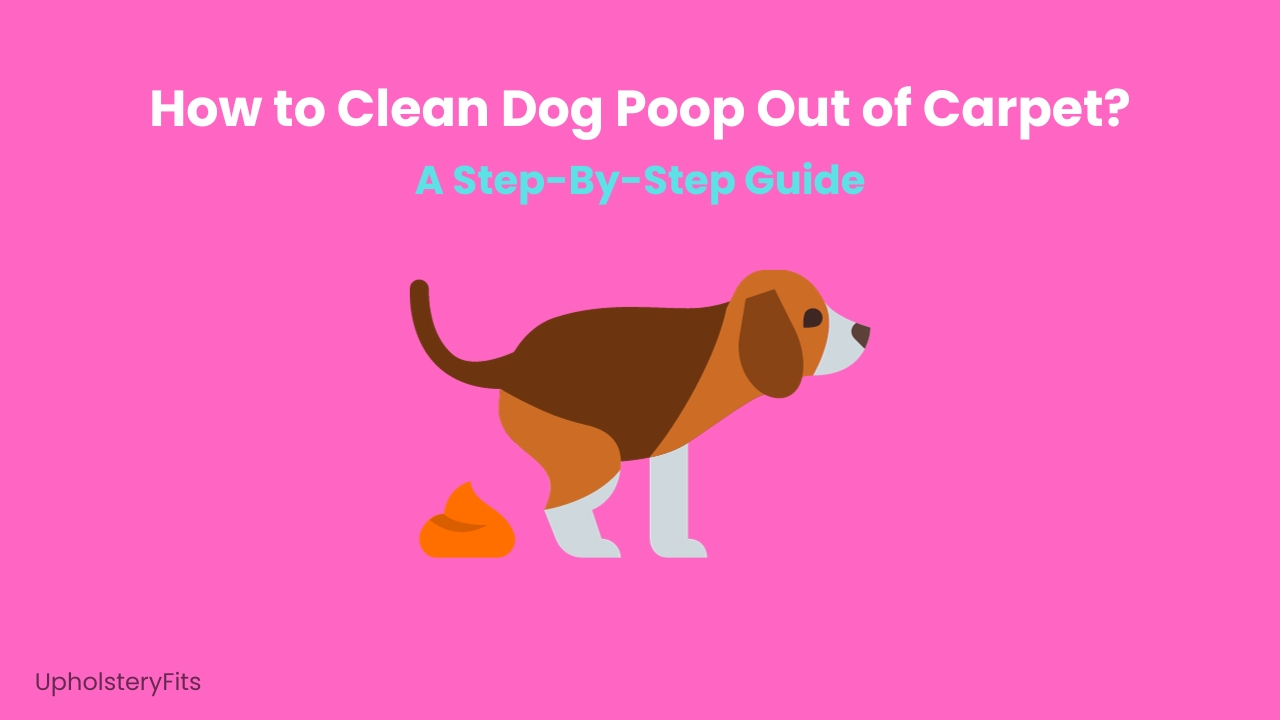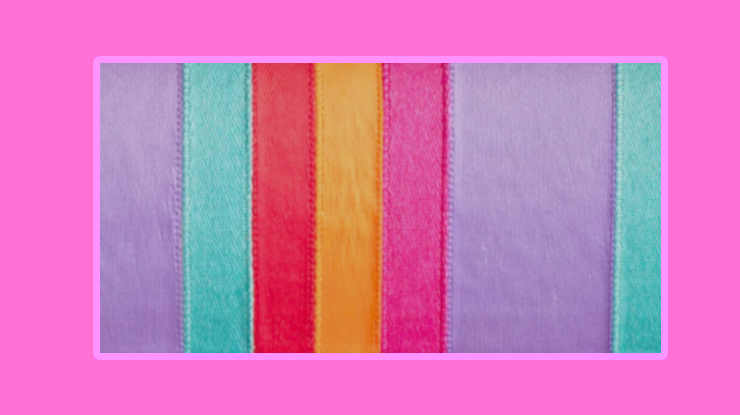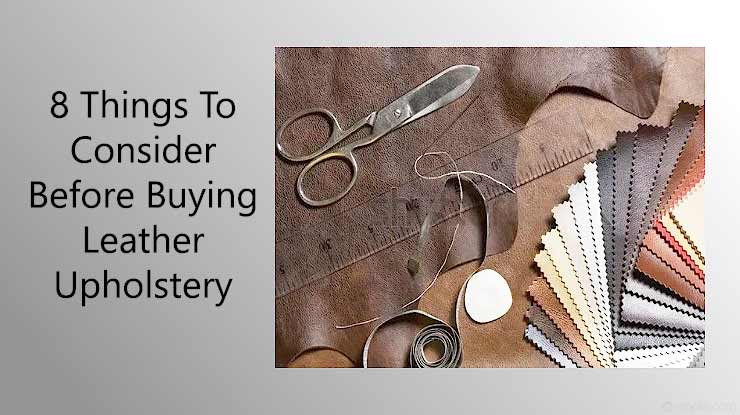Do you have trouble cleaning your dog’s mess? Are you tired of the smell and mess around you all the time?
Don’t worry, you’re not alone in this.
Let’s tackle this stinky challenge together.
I promise, in just two minutes of reading, you’ll discover easy and effective tips and tricks to get rid of that mess once and for all.
Hang in there – help is on the way!
Key Takeaways
Before we get started here are five short bullet points just in case you won’t be able to read it all the way,
- Mix vinegar and water to tackle poop stains; spray, scrub, and repeat!
- Scoop up the big stuff, then hit doggy mess with upholstery spot cleaner and a bleach shampoo.
- Attack poop stains with soapy water, scrub hard, blot with dark towels, and finish with a carpet cleaner.
- If the stain is still there, clean it again; sometimes a second try does the trick!
- Always spot-test cleaning solutions and keep the area well-ventilated for a quick dry and fresh smell.
This is a complete guide on how to remove poop from the carpet, yes your dog’s poop.
I will explain three simple methods.
Trust me you need to read these methods.
Let’s get started!
Preparing for Clean-up
When it comes to cleaning up after your dog, being prepared makes all the difference.
First, ensure you’ve got a sturdy set of disposable gloves to keep things sanitary. You’ll need some reliable poop bags – biodegradable ones are a great eco-friendly choice.
Keep a dedicated scooper handy if you’re in your yard; it’s a real backsaver.
Grab some paper towels for the initial pick-up and a good enzymatic cleaner to tackle any lingering odors and stains.
It’s always good to have these essentials in a specific spot, maybe near your dog’s leash or in a small bin by the door, so you’re always ready for the inevitable.
And hey, don’t forget a little treat for your pooch afterward – after all, accidents happen!
Method 1: Cleaning Poop Out of Carpet Using Vinegar
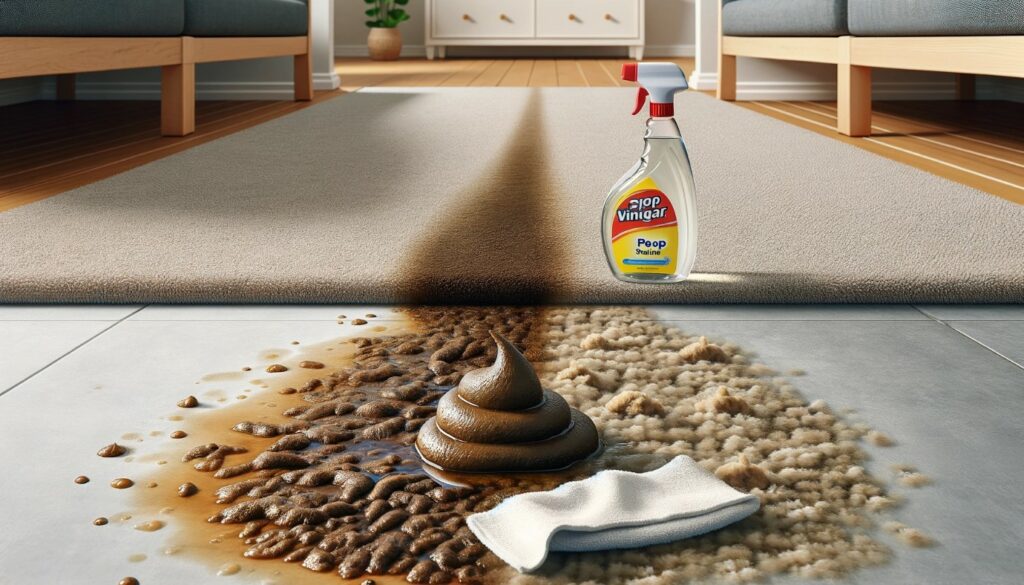
Having a pet or small child can sometimes lead to messy accidents on the carpet.
One such challenge is removing poop stains effectively without damaging your carpet.
Here’s a step-by-step guide to cleaning poop out of your carpet using vinegar.
Prepare the Cleaning Solution:
- Combine straight vinegar with a small amount of water. This dilution is effective yet gentle on carpets.
- If the stain is particularly stubborn, consider using undiluted vinegar for a stronger cleaning action.
Initial Application:
- Generously spray the vinegar solution over the stained area.
- Ensure the area is well-saturated, which helps in breaking down the poop particles.
- For larger or stubborn stains, you might need to repeat the spraying process to ensure complete coverage.
Choosing Your Cleaning Tools:
- Depending on the carpet’s fabric and the stain’s severity, choose an appropriate tool. Options include:
- Paper Towels: Suitable for blotting and absorbing moisture.
- Rags: Ideal for dabbing and gentle scrubbing.
- Scrub Brush: Use this for deeper stains, but be cautious not to damage the carpet fibers.
Blotting and Scrubbing:
- Start by gently blotting the area with a dry paper towel or rag to absorb as much moisture as possible.
- Switch to a scrub brush if needed, but apply gentle pressure to avoid harming the carpet.
- Continue this process until you notice the stain transferring onto the paper towel or rag.
Repeat as Necessary:
- Stubborn stains may require multiple applications.
- If the stain persists after the first attempt, reapply the vinegar solution.
- Allow the area to dry between applications to assess the progress accurately.
Drying the Area:
- Once the stain no longer transfers to your cleaning tool, use a clean, dry towel to blot the area and remove any remaining moisture.
- Allow the carpet to air dry completely. Avoid walking in the area until it is fully dry.
Follow-up Treatment (if needed):
- In cases of very stubborn stains, a second day of treatment might be necessary.
- Reapply the vinegar solution, following the same steps as before.
- Vinegar is not only effective in stain removal but also helps in neutralizing odors.
Final Inspection and Cleaning:
- Once the area is dry, inspect the carpet for any residual stains or odors.
- If any traces of the stain remain, repeat the cleaning process.
- Often, a second or third application will completely remove the stain.
Additional Tips:
- Test the vinegar solution on a small, inconspicuous area of the carpet to ensure colorfastness.
- For sensitive carpets, dilute the vinegar more to prevent potential damage.
- If the odor persists, consider using a carpet freshener or a mixture of baking soda and vinegar for additional odor neutralization.
Method 2: Cleaning Dog Diarrhea from Carpet Using Carpet Cleaner
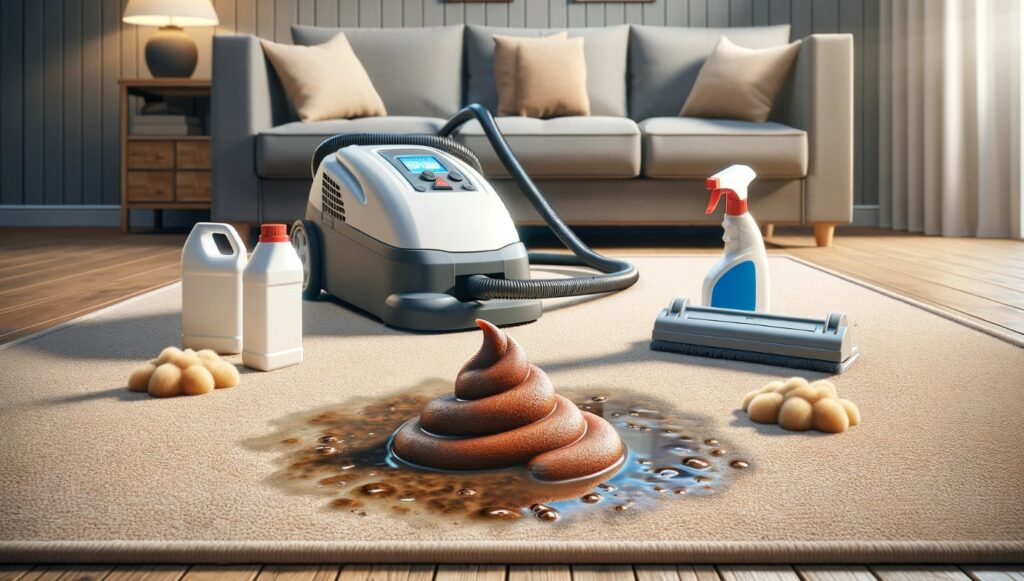
Are you dealing with dog diarrhea on your carpet?
Don’t worry, it’s a common mess for pet owners, but tackling it can be a breeze with a carpet cleaner.
Let’s dive into how this handy tool can not only wipe out those stubborn stains but also get rid of any lingering smells, making your carpet look and smell fresh again!
Initial Cleanup Steps:
- Equip yourself with Walmart bags and paper towels for cleanup.
- Carefully remove the larger chunks of waste, aiming to avoid pushing it further into the carpet fibers.
Understanding the Nature of the Stain:
- Recognize that diarrhea, unlike solid waste, is more challenging due to its consistency. It tends to spread and seep into the carpet more.
Spot Treatment Application:
- After the bulk removal, use a spot treatment cleaner.
- In this case, a Multi-Purpose Cleaner should be repurposed into a spray bottle.
- Avoid using cleaners that could react negatively with bleach, which will be used later.
The Misconception about Vinegar:
- Addressing common cleaning myths, specifically about vinegar.
- Despite popular belief, vinegar can damage carpets by causing separation of the carpet layers.
- Personal experience and anecdotal evidence highlight the risks of using vinegar on carpets, contrary to some online sources.
Preparation for Bleach Cleaning:
- Bleach, despite misconceptions, can be safe and effective for carpets if used correctly.
- Choose scented bleach (like lemon or lavender) for additional odor-fighting properties. Avoid using thick, gel-like bleaches as they foam excessively in machines.
Shampooing Process with Bleach:
- Fill the carpet shampooer with as much bleach as you would normally use shampoo. The proportion should be slightly less than the amount of shampoo.
- Use hot water to enhance the cleaning power of the bleach solution.
Comprehensive Carpet Shampooing:
- Execute slow, deliberate passes over the affected area.
- A pass includes moving forward (laying down the solution) and pulling back (sucking up the solution).
- For extensive coverage, plan to shampoo the entire affected area.
Rinsing After Shampooing:
- After applying the soap solution, a thorough hot water rinse is crucial.
- This step ensures the removal of all soap and bleach residues from the carpet.
Dealing with Smaller Rugs:
- Smaller rugs contaminated with diarrhea should be machine-washed after an initial cleaning with the shampooer. This ensures deep cleaning and odor removal.
Post-Cleaning Ventilation and Odor Control:
- Properly ventilate the cleaned area to allow the carpet to dry and to dispel any lingering bleach odor.
- If odors persist, consider using professional-grade odor neutralizers for a more thorough approach.
Testing Cleaning Products for Safety:
- Always conduct a spot test with any cleaning product on an inconspicuous area of your carpet.
- This ensures the product doesn’t cause damage or discoloration.
Equipment Recommendations for Pet Owners:
- Invest in a high-quality carpet cleaner like Bissell Pet Eraser for homes with pets and children.
- These machines offer deep cleaning capabilities and effectively handle pet hair and tough stains.
Understanding Carpet Warranties and Maintenance:
- Be aware that certain cleaning methods, including DIY shampooing or using certain chemicals, might void carpet warranties.
- Regular professional cleaning is recommended for maintaining the warranty, but in emergencies, immediate DIY cleaning is often necessary.
Method 3: Method for Cleaning Poop from Carpet Using Liquid Soap
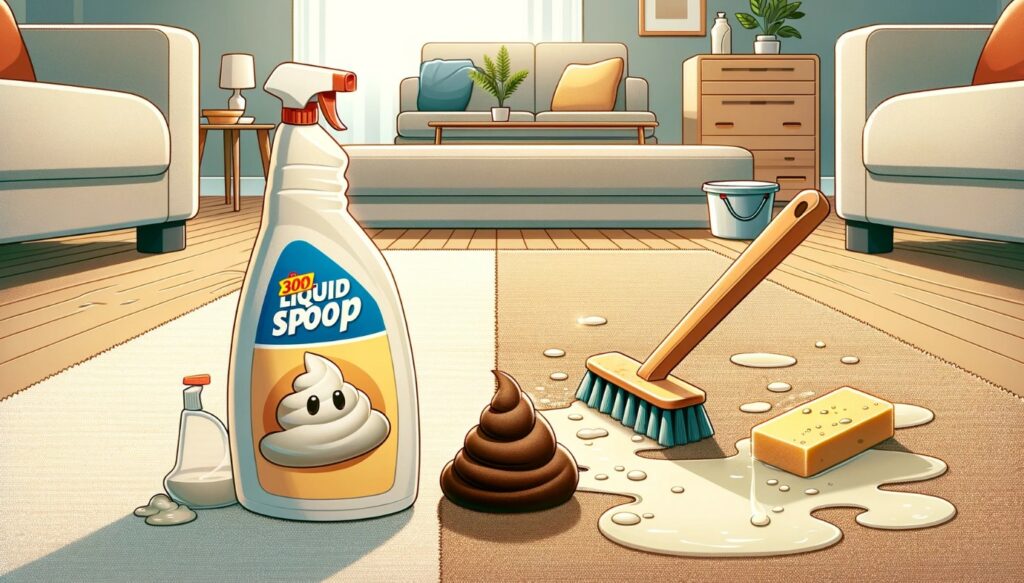
Got poop on your carpet?
No stress. Liquid soap can clean it up quickly and easily.
It’s a simple way to get rid of those bad stains and smells, making your carpet clean and fresh again.
Preparation of Cleaning Solution:
- Mix liquid soap with water in a container. The choice of liquid soap should be based on its effectiveness and gentleness on carpet fabrics.
Application of the Soap Solution:
- Apply the soap solution directly onto the stained area.
- Ensure even distribution to cover the entire affected area.
Scrubbing the Stain:
- After applying the soap solution, use a scrub brush to work on the stain.
- The goal is to penetrate the fibers and break down the waste material.
- Apply a bit of soap and water as needed during the scrubbing process to keep the area moist and to aid in the cleaning process.
Use of Dark Towels for Blotting:
- After scrubbing, blot the area with dark towels.
- Dark towels are recommended as they don’t show stains and can absorb a good amount of moisture.
Employing a Carpet Cleaner:
- Use a quality carpet cleaner for a more thorough cleaning.
- Carpet cleaners are designed to deep clean and extract dirt and liquids from within the carpet fibers.
Switching to Straight Water in the Carpet Cleaner:
- After using the carpet cleaner with a cleaning solution, switch to using just straight water in the machine.
- This step helps in rinsing out any soap residue.
Effective Water Application and Extraction:
- It’s more efficient to have someone pour water while another person uses the carpet cleaner to immediately suck it up.
- This method ensures a thorough rinse and removal of the cleaning solution.
Final Cleaning and Disposal:
- Once the spot is clean, proceed to clean up any other affected areas following the same method.
- When emptying the carpet cleaning bucket, especially for homes with a septic tank, dispose of the contents outside.
- This prevents carpet fibers from clogging up the septic system.
Additional Tips:
- Always test the soap solution on a small, inconspicuous area of your carpet first to ensure it doesn’t cause discoloration or damage.
- Consider ventilating the area well after cleaning to speed up the drying process and dispel any residual odors.
4 Great Tips for Odor Elimination

Dealing with a urine accident on your carpet can leave behind a stubborn, unpleasant odor. But fear not!
With these simple and effective steps, you’ll not only eliminate that pesky smell but also restore the fresh scent of your carpet in no time.
Let’s dive into the world of odor elimination and freshen up your space!
- Blot Up the Urine: Immediately blot up as much urine as possible using clean, white towels or paper towels. This helps prevent the urine from soaking deeper into the carpet fibers.
- Vinegar and Water Solution: Mix equal parts of white vinegar and water. Vinegar is a natural deodorizer that neutralizes urine odors and helps break down urine crystals.
- Apply and Blot the Solution: Apply the vinegar solution to the affected area, let it sit for 15 minutes, then blot it up. Avoid using steam cleaners or heat on the vinegar-treated area.
- Baking Soda Treatment: After blotting, sprinkle baking soda over the area and let it sit for 15-20 minutes. Vacuum it up afterward. Baking soda is excellent for absorbing residual odors.
Odor Neutralizer for Severe Cases:
Sometimes, standard cleaning methods might not be enough, especially in cases of severe or persistent odors.
Here’s a homemade solution that can tackle even the toughest smells:
Homemade Odor Neutralizer: Mix one quart of hydrogen peroxide, ¼ cup of baking soda, and one teaspoon of dishwashing soap. This combination effectively neutralizes a variety of strong odors.
Application: Apply this mixture using a rag or a scrub brush, focusing on areas with the strongest smell. This method is safe for use on floors and various surfaces.
Let it Dry: Allow the area to dry completely after application. The mixture breaks down odor-causing molecules, leaving a clean, fresh smell.
Versatility: This homemade solution is not only effective for pet odors but can also be used for neutralizing smells like skunk spray and strong food odors.
How to Prevent Future Incidents?
Now do you want to keep those “Uh-oh” moments with your pet to a minimum?
Think like a detective, predict your pet’s next move, and outsmart those little accidents.
Here, for your help I’ll share some neat tricks that have worked for me, making life with my four-legged friend a lot cleaner and way more enjoyable.
Ready to turn into a pet mess-prevention pro? Let’s dive in!
Technology and Pet Products
Pet doorbells or potty training bells allow dogs to signal when they need to go outside.
For cats, self-cleaning litter boxes can maintain a clean environment, encouraging regular use.
Furthermore, training pads or waterproof floor mats should be strategically placed in areas where accidents are likely, easing cleanup and protecting your floors.
Understanding Your Pet’s Schedule
One of the best ways to prevent accidents for your pets is to understand and adapt to their bathroom schedule.
Most animals, especially dogs, are creatures of habit. They typically need to relieve themselves after waking up, after eating, and periodically throughout the day.
A regular schedule for walks or outdoor breaks can reduce accidents.
For cats, ensuring that their litter box is always clean and accessible is crucial.
Cats are known for their cleanliness and may refuse to use a dirty litter box, leading to accidents.
Comfortable Environment
Dogs and Cats often respond to stress and environmental changes by having accidents.
To prevent this, you need to ensure that your pet’s living environment is comfortable and consistent.
This includes having a designated area for them to relax and sleep, providing toys for mental stimulation, and avoiding sudden changes in their routine.
For dogs, crate training can be an effective way to provide a safe space and prevent accidents, especially when you are not home.
For cats, multiple litter boxes in different locations can be helpful, particularly in larger homes or multi-level residences.
Training and Reinforcement
Training is essential in preventing accidents.
For dogs, consistent and positive house training from a young age sets a clear expectation of where it’s appropriate to relieve themselves.
Praise and treats can reinforce good behavior.
Similarly, for cats, encouraging the use of a litter box from an early age is crucial. If accidents occur, never punish your pet, as this can lead to anxiety and worsen the problem.
Instead, gently guide them towards the correct behavior and reward them when they follow it.
Regular Health Check-ups
Sometimes, accidents can be a sign of health issues. Regular check-ups are important to ensure that your pet is healthy.
Conditions can lead to unexpected accidents. If your pet suddenly starts having accidents after being reliably trained, it’s wise to consult a veterinarian.
Understanding and addressing any underlying health problems can not only improve their well-being but also prevent future accidents in the house.
Conclusion
And there you have it – your very own cheat sheet to keeping your home spotless and smelling great, even with the furriest of friends! In my quick guide, I covered everything from tackling tough stains to keeping your home accident-free with pets.
Here is a quick recap;
Method #1: Use a mixture of vinegar and water to clean poop from carpets. Apply generously, blot, scrub, and repeat for stubborn stains.
Method #2: For dog mess, start with removing larger chunks, then use a carpet cleaner with bleach, ensuring a thorough rinse afterward.
Method #3: Mix liquid soap and water to clean poop stains, followed by scrubbing, blotting with dark towels, and a final clean with a carpet cleaner.
Odor Elimination Tips: Tackle urine odors with a vinegar-water solution and baking soda treatment. For severe cases, use a homemade odor neutralizer made from hydrogen peroxide, baking soda, and dish soap.
Preventing Future Incidents: Implement pet doorbells, regular bathroom schedules, a comfortable environment, positive training, and regular health check-ups to minimize future messes.
For a more detailed guide on how to clean upholstery and other materials see our other articles.
